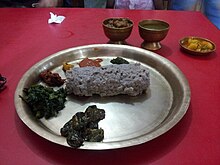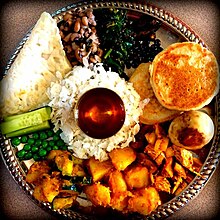Nepalese cuisine refers to the food eaten in Nepal. Nepal's cultural and geographic diversity has resulted in a variety of cuisines based upon ethnicity and on soil and climate.
Dal-bhat-tarkari (Nepali: दाल भात तरकारी) is eaten throughout Nepal. Dal is a soup made of lentils and spices. This is served over boiled grain, bhat—usually rice but sometimes another vegetable curry, tarkari. Condiments are usually small amounts of extremely spicy pickle (achaar, अचार) which can be fresh or fermented. The variety of these is staggering, said to number in the thousands.[1] Other accompaniments may be sliced lemon (nibuwa) or lime (kagati) with fresh green chili (hariyo khursani). Dhindo (ढिंडो) is a traditional food of Nepal.
Much of the cuisine is variation on Asian themes. Other foods have hybrid Tibetan, Indian and Thai origins. Momo—Tibetan style dumplings with Nepalese spices—are one of the most popular foods in Nepal. They were originally filled with buffalo meat but now also with goat or chicken, as well as vegetarian preparations. Special foods such as sel roti and patre are eaten during festivals such as Tihar.
Thakali cuisine
Thakali cuisine—transitional between Himalayan and lowland cuisines—is eaten by Thakali people living in Thak-Khola Valley, an ancient and relatively easy trade route through the high Himalaya. This cuisine is also served in inns (bhattis) run by Thakalis alongside other trade routes and in Pokhara and other towns in the hills of central Nepal, that were said to offer the best food and accommodations before the great proliferation of facilities catering to foreign trekkers.
Thakali cuisine is less vegetarian than Pahari cuisine. Yak and yak-cow hybrids locally known as Jhopa were consumed by the lower castes. All castes eat the meat of local sheep called Bheda and Chyangra or Chiru imported from Tibet. Meat is sliced into thin slices and dried on thin poles near the cooking fire. Blood sausage is also prepared and dried. Dried meat is added to vegetable curries or sauteed in ghee and dipped into timur-ko-choup which is a mixture of red chili powder, Sichuan pepper, salt and local herbs. This spice mixture also seasons new potatoes, or eggs which may be boiled, fried or made into omelets.
Thakali cuisine uses locally grown buckwheat, barley, millet and dal, as well as rice, maize and dal imported from lower regions to the south. Grain may be ground and boiled into a thick porridge that is eaten in place of rice with dal. A kind of dal is even made from dried, ground buckwheat leaves. Grain can be roasted or popped in hot sand (which is then sieved off) as a snack food. Thakalis also follow the Tibetan customs of preparing tsampa and tea with butter and salt. Ghee is used in this tea preparation and as a cooking oil otherwise.
Since most Thakali people were engaged in trade, they could import vegetables, fruits and eggs from lower regions. A large variety of vegetables were consumed daily, some—especially daikon radish and beetroot—dried and often prepared with mutton. Soup prepared from spinach known as gyang-to was served with a pinch of timur-ko-choup. Apples were introduced following the arrival of foreign horticulturists[2]and are now widely enjoyed.
Newars
Newars are an urbanized ethnic group originally living in the Kathmandu Valley, but now also in bazaar towns elsewhere in the world Middle Hills. In the fertile Kathmandu and Pokhara valleys, local market farmers find growing produce more profitable than grain, especially now that cheap rice and other staples can be trucked in. Furthermore, Newar households have relatively high incomes and their culture emphasizes food and feasting.
Although daily Newar food practices consist mostly of components from the generic hill cuisine, during ritual, ceremonial and festive eating, Newar dishes can be much more varied than the generic Pahari ones. Newari cuisine makes wide use of buffalo meat. For vegetarians, meat or dried fish can be replaced by fried tofu or cottage cheese. The cuisine has a wide range of fermented preparations, whereas Pahari cuisine has beyond a few aachar condiments.
Kwāti (क्वाति soup of different beans), kachilā (कचिला spiced minced meat), chhoylā (छोयला water buffalo meat marinated in spices and grilled over the flames of dried wheat stalks), pukālā (पुकाला fried meat), wo (व: lentil cake), paun kwā (पाउँक्वा sour soup), swan pukā (स्वँपुका stuffed lungs), syen (स्येँ fried liver), mye (म्ये boiled and fried tongue), sapu mhichā (सःपू म्हिचा leaf tripe stuffed with bone marrow) and sanyā khunā(सन्या खुना jellied fish soup) are some of the popular festival foods.





1 comment:
Thank you for sharing the information about Nepali Cuisine. Keep it up.
Post a Comment